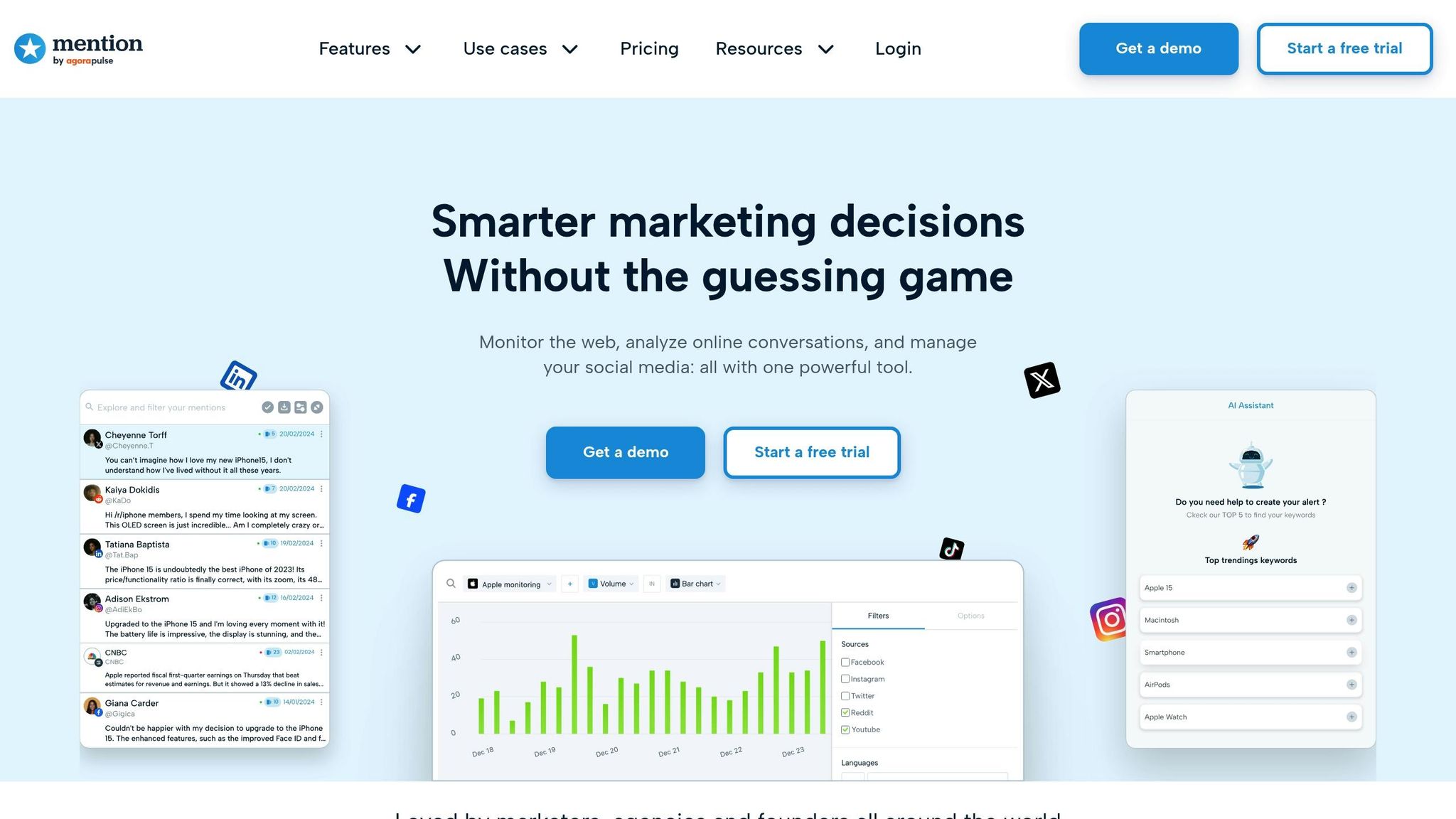Last Updated on August 6, 2025 by Becky Halls
Want to improve your SEO without relying solely on backlinks? Co-citation and co-occurrence are two often-overlooked methods that can help search engines better understand your site’s authority and relevance.
- Co-citation: When two websites are mentioned together on a third-party site, even without direct links, it builds an implied connection.
- Co-occurrence: Focuses on related keywords appearing naturally together in content, helping search engines understand context.
These strategies don’t replace link-building but complement it by providing additional signals to search engines. Here’s why they matter:
- They help establish authority and relevance, even without backlinks.
- They improve rankings by creating semantic connections between terms and sites.
- They focus on quality and context rather than outdated tactics like keyword stuffing.
To implement these strategies, target high-authority sites for mentions, use related terms naturally in your content, and monitor your progress using tools like Google Search Console and Ahrefs. These methods can give your SEO efforts a boost, especially in competitive niches.
Key takeaway: Co-citation and co-occurrence work alongside link-building to provide search engines with a richer understanding of your content and its connections, leading to better search visibility.
What Is Co-Citation? And Why It Matters for University SEO in 2025 – Search Influence
Co-Citation Best Practices Checklist
Building effective co-citation relationships requires a focused strategy that prioritizes quality over sheer volume. The following steps will help you use co-citation to boost your website’s authority and visibility in search results.
Target High-Authority Sites
Start by identifying authoritative websites within your niche to establish a solid co-citation foundation. Use tools like Ahrefs, Moz, or SEMrush to evaluate Domain Authority and pinpoint reputable sites.
For a hands-on approach, search Google for niche-specific keywords and see where competitors are being mentioned. Browser extensions like MozBar can help you quickly check a site’s Domain Authority while browsing.
Competitive research is key here. Analyze where your competitors are being mentioned to uncover potential co-citation opportunities. These sites are already engaging with your industry and are more likely to feature multiple brands in their content.
Set up alerts with tools like Brand24 or Mention to track real-time mentions of your competitors alongside relevant industry terms. This helps you spot trends early and connect with content creators at the right time.
Focus on industry-specific platforms to build credibility. As Edlyn Collanto, B2B Marketing Research Specialist at UpCity, advises:
“The most effective tactic for securing authoritative local citations is to focus on securing listings on prominent review platforms like Yelp, Foursquare, and industry-relevant sites first. These establish a foundation before expanding to citation aggregators. Particularly for reviews, providing good experiences that convert single interactions into enthusiastic advocates willing to publicly share experiences drives high-impact community promotion.”
Once you’ve identified high-authority sites, ensure your mentions are seamlessly integrated into relevant content, which is discussed in the next section.
Maintain Contextual Relevance
For co-citations to be effective, they need to feel natural and fit logically within the content. Your brand should be mentioned alongside competitors or industry leaders in a way that makes sense to readers. Unnatural or forced mentions can harm your SEO efforts and damage relationships with content creators.
Focus on thematic alignment by targeting content directly related to your industry, expertise, or services. For instance, a marketing software company should aim for co-citations in articles about digital marketing tools – not in content about unrelated topics like cooking or travel.
Positive or neutral contexts are the only ones that add value. For example, many marketing blogs mention both SEMrush and Ahrefs when discussing keyword research tools. Even if a post links to only one of these tools, the repeated co-citation across various articles strengthens Google’s association of both brands with keyword research.
The quality of the content where your brand is mentioned also matters. A detailed, well-researched article carries far more weight than a brief mention in low-quality content. Look for opportunities to be featured alongside industry leaders in articles that provide real value to readers.
Monitor Co-Citation Patterns
Regularly track your co-citation patterns using brand monitoring tools to understand how these relationships are evolving and how they impact your SEO performance.
Evaluate the quality and context of each co-citation. Not all mentions are equal – being cited in a respected industry publication is far more impactful than appearing in a low-quality directory or spammy site. Document the domain authority, relevance, and context of the sites where your brand is mentioned.
Identify recurring high-quality sources and adjust your outreach efforts to focus on these opportunities. This helps you zero in on the most effective strategies for building authority.
Consistency is key. Brands that are regularly mentioned alongside industry leaders gain more credibility than those with sporadic mentions. Frequent co-citations signal sustained recognition of your expertise and relevance.
Keep an eye on your competitors’ co-citation patterns to spot gaps in your strategy. If competitors are frequently mentioned alongside certain industry leaders or in specific types of content where you’re absent, these are areas to target for improvement.
Use the data you gather to fine-tune your strategy. Expand on successful co-citation patterns and pivot away from approaches that aren’t delivering results. Regular analysis ensures your efforts stay aligned with your SEO goals and continue to produce measurable outcomes.
Co-Occurrence Best Practices Checklist
Co-occurrence strategies help search engines understand the context of your content by analyzing how related terms appear together. Unlike co-citation, which focuses on external references, co-occurrence happens within your own content. It involves using semantically related keywords and phrases close to one another. When done well, co-occurrence strengthens your content’s clarity and credibility, complementing co-citation techniques to create a more robust SEO strategy.
Use Keywords Naturally
The key to effective co-occurrence is weaving keywords into your content in a way that feels natural to readers while signaling relevance to search engines. Your primary keywords should fit smoothly into sentences and paragraphs, backed by a variety of related terms.
Start with thorough keyword research to identify primary terms and their natural variations. Incorporate these into your headers, titles, and meta descriptions. For example, a food blog post about sourdough bread might include terms like “wild yeast”, “starter”, “proofing”, and “gluten structure.” These related phrases help search engines pinpoint that the topic is sourdough. Similarly, an article discussing “high blood pressure” could use terms like “hypertension”, “cardiovascular health”, and “sodium intake” to establish its relevance.
Natural Language Processing (NLP) tools can also help ensure you’re covering all relevant semantic clusters, making your content more comprehensive.
Focus on Related Terms and Phrases
Beyond using primary keywords, it’s important to include related terms and phrases that enhance your coverage of the topic. This goes beyond simple synonyms to include technical terms, related ideas, and other details that experts in the field would naturally mention.
Review competitor content to identify commonly used related terms and concepts. Including synonyms is particularly helpful, as it allows your content to appear in a wider range of search queries. Additionally, analyzing frequently co-occurring words within your topic can reveal patterns and vocabulary that naturally connect to your main keywords. Place these terms logically and in close proximity to strengthen the overall context of your content.
Avoid Keyword Stuffing
While strategic keyword use is essential, overusing keywords – known as keyword stuffing – can backfire. Not only does it hurt user experience, but search engines are also quick to penalize this outdated tactic.
Modern search engines rely on advanced NLP to identify and penalize keyword stuffing. As Danny Sullivan, Google’s Search Liaison, explains:
“Keyword stuffing is actual spam and tends to be repeating a term in non-sensical patterns over and over. Not always, but people also shouldn’t be paranoid that if they use a term # times then they’ve tipped over into keyword stuffing. It doesn’t really work that way. Instead, it just tends to be not helpful writing.”
Aim for a keyword density of 2–5% while incorporating secondary keywords and long-tail variations to provide extra context. As you write and edit, keep an eye on your keyword usage to ensure it doesn’t feel forced or repetitive.
With the growing use of voice search – now used by nearly 20.5% of people worldwide – writing in a conversational, natural tone has become even more important. This shift highlights the value of prioritizing content that reads well over rigid keyword placement.
sbb-itb-88880ed
Ethical and Technical Guidelines
Ensuring ethical SEO practices means aligning your co-citation and co-occurrence strategies with user intent and the rules set by search engines.
Follow Google’s Webmaster Guidelines
Google’s Webmaster Guidelines act as a blueprint for maintaining a penalty-free website while using co-citation and co-occurrence strategies. These principles aren’t just about avoiding penalties – they’re about creating a foundation for long-term SEO success.
As Matt Bertram, an award-winning Marketing Consultant and SEO Expert, puts it:
“Ethical keyword use balances both of these considerations and is not a compromise but a strategic imperative.”
Start by making sure your links are crawlable so Google can easily navigate between pages on your site. Every page should be linked from at least one other accessible page. Additionally, keep the number of links on each page reasonable and design your site with a clear hierarchy that makes sense to both users and search engines.
Engaging with communities where you can naturally discuss your services or products can also lead to genuine co-citation opportunities. When industry peers reference your work in their content, it boosts your credibility. However, avoid anything that feels forced or manipulative – search engines are quick to spot unnatural patterns and may impose penalties.
Once these practices are in place, regularly evaluate your SEO efforts by auditing your link and mention profile.
Audit Your Link and Mention Profile

To maintain ethical SEO practices, it’s crucial to routinely review your link profile and address any weak spots. A thorough audit of your backlinks ensures your co-citation strategy remains strong and avoids penalties.
Use tools like Google Search Console, Ahrefs, or SEMrush to identify and remove harmful backlinks. Strive for a natural mix of anchor texts, including branded, generic, and exact-match terms.
Brian Harnish, a VIP Contributor at Search Engine Journal, emphasizes:
“As SEOs, Google’s Webmaster Guidelines are just that, guidelines. It can be said that they’re just ‘guidelines’ and not necessarily a rule. But, watch out – if you violate them egregiously, you could be outright banned from the SERPs. I prefer remaining on Google’s good side. Manual actions are ugly.”
Diversify your backlink sources to avoid relying heavily on one type of link or referring domain. A well-rounded profile includes mentions from news outlets, industry blogs, academic websites, and other respected sources in your niche. This variety not only strengthens your co-citation signals but also minimizes risk.
To enhance your efforts, consider using secure platforms for ethical link exchanges.
Use Secure Link Exchange Platforms
Modern SEO calls for secure and ethical link exchange solutions. Traditional methods often lack the oversight needed to meet search engine standards.
Platforms like 3Way.Social provide an AI-powered approach to link exchanges, ensuring they align with ethical SEO practices. Their vetted network connects you with legitimate websites, and their domain matching technology identifies relevant partners for natural co-citation opportunities – avoiding forced or artificial links.
Additionally, 3Way.Social offers features like quality control filters and advanced link diversification to uphold the natural patterns search engines expect. Unlike manual outreach, which can be time-consuming and difficult to track, the platform provides a user-friendly dashboard to monitor exchanges and ensure they align with your SEO strategy.
When evaluating platforms, focus on transparency, detailed reporting, and strict quality standards. The goal is to build partnerships that encourage genuine co-citation – not to manipulate search rankings.
Monitoring backlinks isn’t just about numbers – it’s about protecting your site, spotting opportunities, and ensuring your SEO strategy delivers results. Choose tools and platforms that support a well-rounded approach to link management and co-citation development.
Measuring and Improving Results
Once you’ve put solid strategies into action, the next step is to measure their impact and refine them using accurate data analysis. Without tracking your progress, it’s like navigating without a map – you won’t know if you’re heading in the right direction.
Track Rankings and Traffic
To gauge how well your ethical link-building efforts are working, keep a close eye on rankings and traffic. These metrics reveal how your work translates into search visibility and user engagement. Monitor keyword and URL rankings over time, especially after algorithm updates, to see how richer term associations are influencing your results. Use trusted tools to set alerts for when competitors are mentioned alongside key industry terms, and track unlinked citations to spot potential opportunities.
Nanette Taripe, a Demand Generation Technical SEO Specialist, highlights the importance of tracking multiple metrics:
“To see how well your SEO is working, we keep an eye on metrics like organic traffic, the mix of branded vs. non-branded traffic, clickthrough rates, bounce rates, pages per session, average session duration, organic conversion rates, keyword rankings, backlinks and site speed. All of these metrics tell you a lot about what’s working and where you can improve.”
Click-through rates (CTR) are particularly insightful. For example, the top search result on Google typically gets a CTR of 27.6%, while the second and third results see 15.8% and 11.0%, respectively. A good overall site CTR benchmark is between 2% and 3%, with individual page CTRs often falling in the 1% to 2% range.
Analyze Performance Data
Dive into your performance data to measure the effectiveness of your co-citation and co-occurrence strategies. Tools like Google Search Console provide valuable insights into clicks and impressions, while Google Analytics 4 helps you understand user behavior and engagement patterns. For more advanced analysis, platforms like SEMrush and Ahrefs can reveal competitor performance and backlink insights.
Engagement metrics such as bounce rate, time on page, and user flow patterns are also crucial. They help you understand how well your content connects with your audience. Don Gruspe, an SEO Specialist at Thrive, explains:
“Engagement metrics like bounce rate and session duration are vital to SEO success because they show how well your content connects with visitors. A high engagement rate means search engines see your content as valuable and relevant for your audience, which [in turn] helps improve your rankings and attract more organic traffic.”
For even deeper insights, use tools like Surfer SEO or Clearscope to identify frequently co-occurring phrases in top-performing competitor content. You can also leverage NLP (Natural Language Processing) tools, such as Google’s Natural Language API or IBM Watson NLU, to ensure your content includes the right semantic clusters.
It’s important to remember that SEO success isn’t about chasing a single metric. As Nanette Taripe notes:
“SEO success isn’t [measured by] a single metric, but rather [about how you’re] achieving your business goals. Instead of looking at each metric as a stand-alone indicator of success, we look at how each facet of your SEO strategy feeds into your overarching business goals.”
Compare Co-Citation vs. Co-Occurrence Results
Once you’ve gathered performance metrics, compare the results of co-citation and co-occurrence strategies. Knowing when to prioritize one over the other depends on how each impacts your SEO goals. Here’s a quick breakdown:
| Strategy | Primary Benefits | Best Use Cases | Key Metrics to Track |
|---|---|---|---|
| Co-Citation | Builds authority and credibility through associations | Brand building, thought leadership, competitive positioning | Brand mentions, citation frequency, domain authority improvements |
| Co-Occurrence | Enhances topic depth and semantic clarity | Content optimization, keyword targeting, topical relevance | Keyword rankings, organic traffic, engagement metrics |
| Link Building | Provides direct SEO boosts and referral traffic | Direct SEO impact, referral traffic generation | Backlink count, referring domains, link quality scores |
For example, an e-commerce store specializing in camping gear saw improved rankings after optimizing product descriptions and blog posts with co-occurring phrases like “camping gear” and “hiking boots”.
When comparing results, focus on metrics like conversion rates and goal completions in Google Analytics. These indicators reveal how effectively your strategies turn visits into meaningful outcomes. Adjust the placement of co-occurring phrases based on user engagement data, and regularly update your content to include emerging terms that resonate with your audience. This ongoing process ensures your strategies stay relevant as search trends and user behaviors evolve.
Conclusion
In the earlier sections, we delved into how a well-rounded SEO strategy can effectively combine co-citation, co-occurrence, and traditional link-building. These often-overlooked techniques can elevate your SEO efforts by clarifying connections between websites and keywords without needing direct links. Together, they add depth and value to your overall strategy.
Key Takeaways
The main takeaway is that co-citation and co-occurrence should work alongside traditional link-building, not replace it. Each approach has a unique role: co-citation establishes authority through associations, while co-occurrence enhances topic relevance and context.
Using these methods ethically is crucial to maintaining your brand’s reputation and avoiding penalties from search engines. The priority should always be creating content that genuinely helps users and offers better information than your competitors.
Co-citation, in particular, can naturally boost brand awareness and improve rankings. As the SEO Professor aptly puts it:
“co-citation just means Google is getting smart enough to realize not everyone links, but everyone talks.”
By leveraging these techniques, you can enjoy benefits like a more diverse link profile, stronger topical authority, and better search visibility – even without relying heavily on direct backlinks. In fact, co-citation can improve rankings even when specific keywords aren’t directly linked. This makes it especially useful in competitive niches where traditional link-building might be tougher to achieve.
Next Steps
To make the most of these strategies, here are some practical steps to integrate them into your SEO plan:
- Work closely with your content team to incorporate structured data and schema markup. This strengthens your entity’s online identity and boosts co-citation opportunities.
- Set up alerts to track when competitors are mentioned alongside key industry terms. These unlinked mentions can be opportunities for co-citation.
- Use NLP (Natural Language Processing) tools to ensure your content includes the right semantic clusters for co-occurrence. Analyze top-performing competitor articles to identify frequently co-occurring phrases and enhance your own content.
For a more streamlined approach, consider using tools like 3Way.Social. This platform leverages AI to facilitate ethical link exchanges, helping you build quality backlinks that complement co-citation and co-occurrence efforts. The result? A stronger, more diversified SEO profile.
Finally, make monitoring and adjustments a regular part of your process. Track ranking changes in relation to co-citation and co-occurrence patterns by keeping an eye on specific URLs and keyword clusters over time. Periodically update your content to reflect emerging terminology and trends that resonate with your audience. For detailed tracking methods, refer to our measurement guidelines.
FAQs
How do I find high-authority websites for co-citation in my industry?
To find high-authority websites for co-citation in your industry, focus on platforms with strong domain authority (DA). Well-known examples include LinkedIn and Google My Business. Tools like Ahrefs and SEMrush can be incredibly useful for analyzing backlinks from trusted sources, such as academic institutions, government sites, or major industry leaders.
You can also look into curated lists of citation websites or leverage co-citation analysis tools to discover authoritative domains that fit your niche. Make sure to choose websites that resonate with your audience and align with your content to create meaningful and responsible co-citation opportunities.
What are the best tools to track and measure the impact of co-citation and co-occurrence on my SEO strategy?
To keep tabs on how co-citation and co-occurrence influence your SEO, tools like Google Search Console and advanced SEO platforms are incredibly helpful. These tools let you track keyword performance, analyze backlinks, and assess search visibility. They provide detailed data that you can use to fine-tune your SEO strategy.
If you’re looking for a deeper dive, some emerging tools are designed specifically to analyze co-citation and co-occurrence metrics. That said, their reliability and availability can differ. It’s important to select tools that align with your objectives and offer precise, real-time insights.
How can I use co-occurrence effectively without risking keyword stuffing or SEO penalties?
To make the most of co-occurrence without falling into the trap of keyword stuffing, prioritize creating natural, engaging content that enhances the reader’s experience. Instead of repeating the same keywords over and over, use a mix of related terms and phrases that fit seamlessly into your writing.
Strike a balance with keyword usage by ensuring they flow naturally within the content. Avoid cramming keywords into places where they feel forced or unnecessary – this not only disrupts the reading experience but can also negatively impact your search rankings and trigger SEO penalties. Focus on writing that’s clear, valuable, and easy to read, which will benefit both your audience and your search engine visibility.



